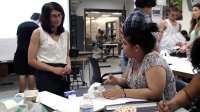Creating Interdisciplinary Projects
Visit a school where teachers collaborate on projects that connect several subject areas to enhance learning.
Overview
Integrated Learning: One Project, Several Disciplines
At High Tech High School, students choose one of several vocational majors that are offered. These include architecture, engineering, culinary arts, graphic design, film/video, science research, theater, or dance. In addition to the vocational majors, students take all the regular academic courses required of high school students, including language arts, math, social studies, and science.
High Tech teachers find ways to collaborate and integrate vocational and academic content through projects that span multiple disciplines. Teachers have found that student interest in their vocations helps to drive their learning in many of the academic areas. When teachers collaborate and build these connections into the curriculum, students thrive, feel more engaged in the learning, and make real-world connections to what they are learning.
How It's Done
At High Tech High School, each student selects a vocational major. For example, within the Performing Arts academy, a student can major in drama, dance, or musical theater. In the Media Arts academy, a student can major in film/video, graphic design, photography, or studio art. Each of these majors drives students' learning throughout their four years at High Tech.
The school encourages vocational and academic teachers to collaborate and integrate as they can. Sometimes this is done across the grade level, so that the 11th grade math teacher is working with the 11th grade dance teacher. At other times, it's done with a whole cohort of teachers working within a grade level. Teachers meet during common planning times or before and after school. They also have a summer planning sessions that allow them to explore new ideas or build themes across classes and disciplines.
Much of the collaboration is focused around a particular theme, and culminates in a specific project that students create. Projects are used to make connections and show relevancy. Usually the vocational teacher will lead the project, and the academic teachers find ways to fit in and integrate their content. Projects can last anywhere from two weeks to a whole semester. The goal is collaborating and finding ways to work together, so that students can view and engage material from multiple perspectives.
Architecture Project
In the Architecture and Engineering academy, five teachers work in a cohort, including architecture, language arts, science, history, and math teachers.
As part of the architecture curriculum, High Tech's architecture teacher Greg Simon introduces students to the idea of biophilic design, in which bases the design ideas are based on aspects of the natural world.
For the past six years, tenth grade architecture students have been going on a field trip to the Pocono Environmental Education Center, located within a national park in Pennsylvania, just across the Delaware River from New Jersey. The purpose of the trip is for students to interact with nature and ultimately demonstrate their technical skill acquisition and their understanding of architecture by designing a pavilion that would be site specific to this space. During the site visit, students take photographs of the area, look at the changes in the topography, and figure out different variables to consider when designing their pavilions.
The students typically come back from the field trip with observations and ideas about something that struck them on the trip -- whether it's the pattern that they saw on a leaf, or the moss on the shady side of a tree. They begin a design process where that concept is picked apart and synthesized into something that will eventually be a site-specific structure.
Integration From Other Disciplines
The entire architecture project spans five weeks, and the other teachers in the cohort are invited to integrate as they see fit. For example, the science teacher might easily connect concepts of plant biology to what students are thinking about as they look for design elements in nature. The social studies teacher might enter the project through the history of national parks and Theodore Roosevelt's work in shaping them. These curriculum connections could last a week or two rather than being integrated for the entire five weeks of the project. The idea is finding those points of integration that make sense for the teachers and students, thereby creating a richer learning experience.
Inside the Classroom
In addition to the work that teachers do in their own classroom, the architecture, science, and social studies teachers joined the model-building phase of the architecture project to help and support students, ask questions, offer a new perspective on their design, and help them push through any obstacles. For example, the science teacher may ask about issues around sustainability, materials, or how the sun rotates around the site and what effect it will have on the pavilion. The social studies teacher may have a perspective on the types of monuments and buildings that have already been created, and on how memorials work in space.
Projects Show Relevancy
The final requirements for the architecture project are that students complete scale drawings of their proposal and a model built to scale. Students also give a final presentation of their work, where they not only discuss their proposals but also reflect on the design process, from field trip to executed design model. This often includes references to the other content areas that were integrated into the class -- whether it is the science or social studies perspective that has allowed them to complete the final stages of their project.
